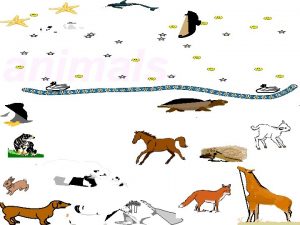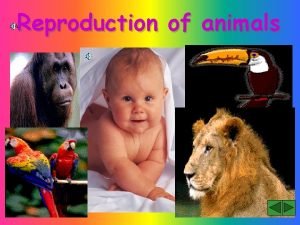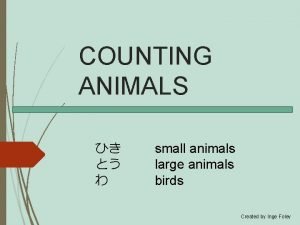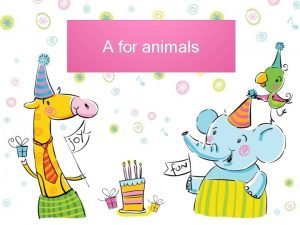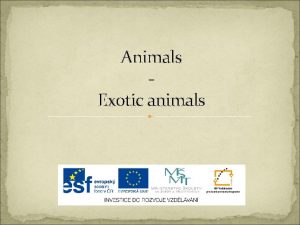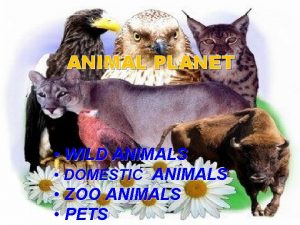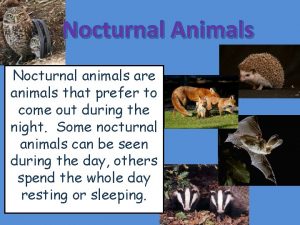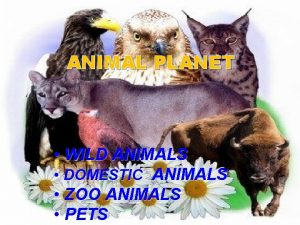Friday 1 st May of Animals Match the














- Slides: 14

Friday 1 st May of Animals

Match the types of teeth with their names. Molar Canine Incisor Premolar

Were you correct? Click here for answers! Canine Molars Premolars Incisors Wisdom Teeth

Canine Molars Premolars Incisors Wisdom Teeth Do you remember why we have different types of teeth and what their purpose is?

Humans have 8 incisors altogether; 4 in the upper jaw and 4 in the lower jaw. Incisors are shovel shaped. Used for biting and cutting food.

Humans have 4 canine teeth, one in each quarter of the mouth, on either side of the incisors. Canines are pointy. Used for tearing and ripping food.

Humans have 8 premolars, two in each quarter of the mouth. They are between the canine tooth and the molars. Small and flat Holding and crushing food.

Humans have 8 molars, two in each quarter of the mouth. They are at the back of the mouth behind the premolars. Large and flat Grinding food

Humans can have up to 4 wisdom teeth, although not everyone has them. There is 1 in each quarter of the mouth behind the molars. Large and flat (they are just a third molar) Does not have one now! Some scientists think that human ancestors needed a third molar to help grind down plant tissue from thicker leaves when humans still ate them. Since the diet of humans has changed we don’t need them. As the human diet changed our mouths have become smaller. This is the reason why many people have their wisdom teeth extracted – taken out – as there is no real room for a wisdom tooth so it tends to grow inward and can become a problem.

Do animals have the same type of teeth as humans? Why not?

Herbivores eat plants Carnivores eat only meat Omnivores eat plants and meat Discuss with a talk partner: How does the food the animal eats affect the teeth it will have? What similarities and differences do you notice? Human Sheep Lion skull. Clickagainto to togo go goback.

Lion 1. Incisors, the smallest teeth at the front of the mouth, are used for gripping and tearing meat. 2. Canines, the four largest teeth (either side of the incisors), can reach up to 7 cm in length. They are used to rip skin and tear away meat. 3. Premolars, to hold and crush their meat. Lions are carnivores, which means they feed on other animals so their teeth need to match their diet. Lions have 30 adult teeth, 4 different types of teeth. 12 incisors, 4 canines, 10 premolars and 4 carnassial teeth. 4. Carnassial, the sharpest teeth at the back of the mouth, act like a pair of scissors to cut meat. Lions can open their jaws to up 28 cm wide, giving them one of the animal kingdom’s biggest bites!

Sheep 8 incisors at the front of the lower jaw, used to nibble grass. None in the upper jaw, instead they have a hard plate. They grind their incisors against the hard plate. Sheep are herbivores, which means they feed on plants so their teeth need to match their diet. Sheep have 32 teeth, 8 incisors and the rest are premolars and molars. There is a space between the incisors and the premolars and molars. These teeth are found at the back of the mouth in both the upper and lower jaw. Used to chew the grass.

Now you have looked at teeth from two different animals. Do they have different teeth? Why? Choose another 2 different animals and research what teeth they have and why and what their functions are. Create a non chronological report for each.
 Parasitic food chain example
Parasitic food chain example Animals that eat both plants and animals
Animals that eat both plants and animals Https//a-z-animals.com
Https//a-z-animals.com Is a horse a producer consumer or decomposer
Is a horse a producer consumer or decomposer Hci patterns
Hci patterns ưu thế lai là gì
ưu thế lai là gì Các môn thể thao bắt đầu bằng từ đua
Các môn thể thao bắt đầu bằng từ đua Tư thế ngồi viết
Tư thế ngồi viết Hình ảnh bộ gõ cơ thể búng tay
Hình ảnh bộ gõ cơ thể búng tay Cái miệng nó xinh thế chỉ nói điều hay thôi
Cái miệng nó xinh thế chỉ nói điều hay thôi Mật thư tọa độ 5x5
Mật thư tọa độ 5x5 Tư thế ngồi viết
Tư thế ngồi viết V cc
V cc Chó sói
Chó sói Thẻ vin
Thẻ vin
















